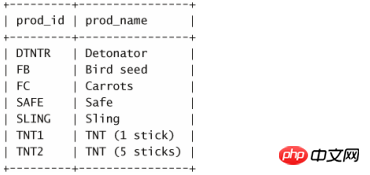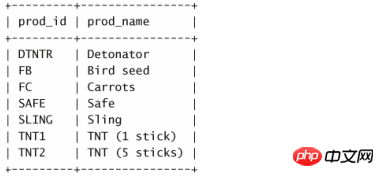mysql advanced join-self-join usage examples
Self-Join
As mentioned before, one of the main reasons for using table aliases is to reference the same table more than once in a single SELECT statement. Here's an example.
Suppose you find a problem with an item (whose ID is DTNTR ) and want to know if other items produced by the supplier that produces this item also have these problems. This query requires first finding the supplier
that produces the item with ID DTNTR, and then finding other items produced by this supplier.
Here is one way to solve this problem:
Input:
select prod_id,prod_name from products where vend_id = (select vend_id from products where prod_id = 'DTNTR');
Output:

Analysis: This is the first solution, which uses subqueries. The inner SELECT statement does a simple search and returns the vend_id of the item supplier whose production ID is DTNTR. This ID is used in the WHERE clause of the outer query to retrieve all items produced by this supplier.
Now look at the same query using joins:
Input:
select p1.prod_id,p1.prod_name from products as p1,products as p2 where p1.vend_id = p2.vend_id and p2.prod_id = 'DTNTR';
Output:
Analysis: This The two tables required in the query are actually the same table, so the products table appears twice in the FROM clause. Although this is perfectly legal, the reference to products is ambiguous because MySQL does not know which instance in the products table you are referring to. To solve this problem, table aliases are used. The first occurrence of products is the alias p1 , and the second occurrence is the alias p2 . These aliases can now be used as table names. For example, a SELECT statement uses the p1 prefix to explicitly give the full name of the required column. If not, MySQL will return an error because there are two columns named prod_id and prod_name respectively. MySQL doesn't know which column is wanted (even though they are actually the same column). WHERE (by matching vend_id in p1 and vend_id in p2) first joins the two tables, then filters the data by prod_id in the second table, returning the required data.
To solve this problem, table aliases are used. The first occurrence of products is the alias p1 , and the second occurrence is the alias p2 . These aliases can now be used as table names. For example, a SELECT statement uses the p1 prefix to explicitly give the full name of the required column. If not, MySQL will return an error because there are two columns named prod_id and prod_name respectively. MySQL doesn't know which column is wanted (even though they are actually the same column). WHERE (by matching vend_id in p1 and vend_id in p2) first joins the two tables, then filters the data by prod_id in the second table, returning the required data.
Use self-joins instead of subqueries. Self-joins are often used as external statements to replace subquery statements used when retrieving data from the same table. Although the end result is the same, sometimes processing joins is much faster than processing subqueries. You should try both methods to determine which performs better.
The above is the detailed content of mysql advanced join-self-join usage examples. For more information, please follow other related articles on the PHP Chinese website!

Hot AI Tools

Undresser.AI Undress
AI-powered app for creating realistic nude photos

AI Clothes Remover
Online AI tool for removing clothes from photos.

Undress AI Tool
Undress images for free

Clothoff.io
AI clothes remover

AI Hentai Generator
Generate AI Hentai for free.

Hot Article

Hot Tools

Notepad++7.3.1
Easy-to-use and free code editor

SublimeText3 Chinese version
Chinese version, very easy to use

Zend Studio 13.0.1
Powerful PHP integrated development environment

Dreamweaver CS6
Visual web development tools

SublimeText3 Mac version
God-level code editing software (SublimeText3)

Hot Topics
 1385
1385
 52
52
 MySQL: Simple Concepts for Easy Learning
Apr 10, 2025 am 09:29 AM
MySQL: Simple Concepts for Easy Learning
Apr 10, 2025 am 09:29 AM
MySQL is an open source relational database management system. 1) Create database and tables: Use the CREATEDATABASE and CREATETABLE commands. 2) Basic operations: INSERT, UPDATE, DELETE and SELECT. 3) Advanced operations: JOIN, subquery and transaction processing. 4) Debugging skills: Check syntax, data type and permissions. 5) Optimization suggestions: Use indexes, avoid SELECT* and use transactions.
 How to open phpmyadmin
Apr 10, 2025 pm 10:51 PM
How to open phpmyadmin
Apr 10, 2025 pm 10:51 PM
You can open phpMyAdmin through the following steps: 1. Log in to the website control panel; 2. Find and click the phpMyAdmin icon; 3. Enter MySQL credentials; 4. Click "Login".
 MySQL: An Introduction to the World's Most Popular Database
Apr 12, 2025 am 12:18 AM
MySQL: An Introduction to the World's Most Popular Database
Apr 12, 2025 am 12:18 AM
MySQL is an open source relational database management system, mainly used to store and retrieve data quickly and reliably. Its working principle includes client requests, query resolution, execution of queries and return results. Examples of usage include creating tables, inserting and querying data, and advanced features such as JOIN operations. Common errors involve SQL syntax, data types, and permissions, and optimization suggestions include the use of indexes, optimized queries, and partitioning of tables.
 Why Use MySQL? Benefits and Advantages
Apr 12, 2025 am 12:17 AM
Why Use MySQL? Benefits and Advantages
Apr 12, 2025 am 12:17 AM
MySQL is chosen for its performance, reliability, ease of use, and community support. 1.MySQL provides efficient data storage and retrieval functions, supporting multiple data types and advanced query operations. 2. Adopt client-server architecture and multiple storage engines to support transaction and query optimization. 3. Easy to use, supports a variety of operating systems and programming languages. 4. Have strong community support and provide rich resources and solutions.
 How to use single threaded redis
Apr 10, 2025 pm 07:12 PM
How to use single threaded redis
Apr 10, 2025 pm 07:12 PM
Redis uses a single threaded architecture to provide high performance, simplicity, and consistency. It utilizes I/O multiplexing, event loops, non-blocking I/O, and shared memory to improve concurrency, but with limitations of concurrency limitations, single point of failure, and unsuitable for write-intensive workloads.
 MySQL and SQL: Essential Skills for Developers
Apr 10, 2025 am 09:30 AM
MySQL and SQL: Essential Skills for Developers
Apr 10, 2025 am 09:30 AM
MySQL and SQL are essential skills for developers. 1.MySQL is an open source relational database management system, and SQL is the standard language used to manage and operate databases. 2.MySQL supports multiple storage engines through efficient data storage and retrieval functions, and SQL completes complex data operations through simple statements. 3. Examples of usage include basic queries and advanced queries, such as filtering and sorting by condition. 4. Common errors include syntax errors and performance issues, which can be optimized by checking SQL statements and using EXPLAIN commands. 5. Performance optimization techniques include using indexes, avoiding full table scanning, optimizing JOIN operations and improving code readability.
 MySQL's Place: Databases and Programming
Apr 13, 2025 am 12:18 AM
MySQL's Place: Databases and Programming
Apr 13, 2025 am 12:18 AM
MySQL's position in databases and programming is very important. It is an open source relational database management system that is widely used in various application scenarios. 1) MySQL provides efficient data storage, organization and retrieval functions, supporting Web, mobile and enterprise-level systems. 2) It uses a client-server architecture, supports multiple storage engines and index optimization. 3) Basic usages include creating tables and inserting data, and advanced usages involve multi-table JOINs and complex queries. 4) Frequently asked questions such as SQL syntax errors and performance issues can be debugged through the EXPLAIN command and slow query log. 5) Performance optimization methods include rational use of indexes, optimized query and use of caches. Best practices include using transactions and PreparedStatemen
 How to build a SQL database
Apr 09, 2025 pm 04:24 PM
How to build a SQL database
Apr 09, 2025 pm 04:24 PM
Building an SQL database involves 10 steps: selecting DBMS; installing DBMS; creating a database; creating a table; inserting data; retrieving data; updating data; deleting data; managing users; backing up the database.




